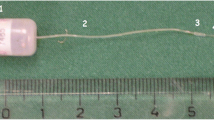Summary
The effect of the complement-derived polypeptide C3adesArg as a mediator of inflammation in the central nervous system was examined. Twenty-five anesthetized cats received 4 mg of this polypeptide by intraventricular injection, 20 cats who served as controls received saline. Cerebrospinal fluid (CSF) was sampled 3 h after intraventricular injection and the brains were removed. For assessment of the permeability of the blood-brain barrier the CSF penetration of four antibiotics, which were given intravenously, was measured. Five control animals were employed for each antibiotic (tobramycin, ampicillin, imipenem, fosfomycin), whereas six C3adesArg-treated animals were used for each antibiotic and seven for tobramycin. Besides CSF levels of glucose, the prostanoids 6-keto-prostaglandin F1α, thromboxane B2 and prostaglandin E2 were measured. The morphological examinations in the CSF sediments and histological brain sections in the C3adesArg-treated animals disclosed a distinct inflammation with leptomeningeal and perivascular infiltration of polymorphonuclear granulocytes compared to normal findings in the controls. The CSF/serum ratios of all of the antibiotics were markedly elevated compared to controls, indicating a blood-brain barrier disruption. The levels of all prostanoids were significantly higher in the treatment group than in the control group, whereas the glucose levels were lower. These findings are in accordance with a granulocytic meningitis as seen in some infections at the acute stage. It is concluded that C3adesArg acts as a mediator of inflammation in the central nervous system.
Similar content being viewed by others
References
Barrett FF, Eardley WA, Yow MD, Leverett HA (1966) Ampicillin in the treatment of acute suppurative meningitis. J Pediatr 69:343–353
Bitter-Suermann D (1982) Contribution of complement factors and reaction pathways to inflammation. Agents Actions [Suppl] 11:159–178
Brückner O, Alexander M, Collmann H (1981) Tobramycin levels in cerebrospinal fluid of patients with slightly and severely impaired blood-cerebrospinal barrier. Chemotherapy 27:302–308
Cochrane CG (1984) The role of complement in experimental disease models. Springer Semin Immunopathol 7:263–270
Cochrane CG, Müller-Eberhard HJ (1968) The derivation of two distinct anaphylatoxin activities from the third and fifth components of human complement. J Exp Med 127:371–386
Cooper NR (1980) The complement system. In: Fudenberg HH, Stites DP, Caldwell JL, Wells JW (eds) Basic and clinical immunology, 3rd edn. Lange Medical Publications, Los Altos, pp 83–95
Damerau B, Grünefeld E, Vogt W (1978) Chemotactic effects of the complement-derived peptides C3a, C3ai, and C5a (classical anaphylatoxin) on rabbit and guinea-pig polymorphonuclear leukocytes. Naunyn-Schmiedeberg's Arch Pharmacol 305:181–184
Damerau B, Höllerhage H-G, Vogt W (1978) Effects of the cleavage peptides C3a and C3ai from the third component of hog complement on leukocyte accumulation and vascular permeability in vivo. Naunyn-Schmiedeberg's Arch Pharmacol 302:45–50
Damerau B, Zimmermann B, Grünefeld E, Czorniak K, Vogt W (1980) Biological activities of C5a and C5adesArg from hog serum. Int Arch Allergy Appl Immunol 63:408–414
Ernst JD, Hartiala KT, Goldstein IM, Sande ME (1984) Complement (C5)-derived chemotactic activity accounts for accumulation of polymorphonuclear leukocytes in cerebrospinal fluid of rabbits with pneumococcal meningitis. Infect Immun 46:81–86
Gamache DA, Povlishock JT, Ellis EF (1986) Carrageenan-induced brain inflammation. Characterization of the model. J Neurosurg 65:679–685
Höllerhage H-G (1988) Die Permeabilität der Bluthirnschranke unter entzündlichen Bedingungen. Thieme, Stuttgart (in press)
Höllerhage H-G, Wiegand H, Stolke D, Dietz H (1986) The effect of the cleavage peptide C3adesArg of the third complement component on the accumulation of leukocytes in cerebrospinal fluid (CSF) and on the permeability of the blood-CSF barrier. Adv Neurosurg 14:252–256
Hugli TE (1981) The structural basis for anaphylatoxin and chemotactic functions of C3a, C4a and C5a. CRC Crit Rev Immunol 1:321–366
Hugli TE (1984) Structure and function of the anaphylatoxins. Springer Semin Immunopathol 7:193–219
Kaplan AP, Silverberg M, Dunn JT, Ghebrehiwet B (1982) Interaction of the clotting, kinin-forming, complement, and fibrinolytic pathways in inflammation. Ann NY Acad Sci 389:25–38
Luskin AT, Tobin MC (1982) Alterations of complement components in disease. Am J Med Technol 48:749–756
Modai J, Vittecoq D, Decazes JM, Meulemans A (1985) Penetration of imipenem and cilastatin into cerebrospinal fluid of patients with bacterial meningitis. J Antimicrob Chemother 16:751–753
Nosko N, Schulz R, Weir B, Cook DA, Grace M (1988) Effects of vasospasm on levels of prostacyclin and thromboxane A2 in cerebral arteries. Neurosurgery 22:45–50
Pfeifer G, Frenkel C, Entzian W (1985) Pharmacokinetic aspects of cerebrospinal fluid penetration of fosfomycin. Int J Clin Pharmacol Res 3:171–174
Reinoso-Suarez F (1961) Topographischer Hirnatlas der Katze für experimental-physiologische Untersuchungen. Merck, Darmstadt
Rennels ML, Gregory TF, Blaumanis OR, Fujimoto K, Grady PA (1985) Evidence for a “paravascular” fluid circulation in the mammalian central nervous system, provided by the rapid distribution of tracer protein throughout the brain from the subarachnoidal space. Brain Res 326:47–63
Romero SD, Chyatte D, Byer DE, Romero JC, Yaksh TL (1984) Measurement of prostaglandins in the cerebrospinal fluid in cat, dog, and man. J Neurochem 43:1642–1649
Vogt W (1983) Activation of the complement system. Agents Actions 13:391–397
Ward PA (1971) Complement-derived leukotactic factors in pathological fluids. J Exp Med 134:109–113
White RP, Hagan AA (1982) Cerebrovascular actions of prostaglandins. Pharmacol Ther 18:313–331
Whittle HC, Greenwood BM (1977) Cerebrospinal fluid immunoglobulins and complement in meningococcal meningitis. J Clin Pathol 30:720–722
Williams TJ (1979) Prostaglandin E2, Prostaglandin I2 and the vascular changes of inflammation. Br J Pharmacol 65:517–524
Wolfe LS, Coceani F (1979) The role of prostaglandins in the central nervous system. Annu Rev Physiol 41:669–684
Zimmermann B, Damerau B, Vogt W (1980) Purification and partial amino acid sequence of classical anaphylatoxin from pig serum; identification with des-Arg-C5a. Hoppe-Seyler's Z Physiol Chem 361:915–924
Zwahlen A, Nydegger UE, Vaudaux P, Lambert PH, Waldvogel FA (1982) Complement-mediated osponic activity in normal and infected human cerebrospinal fluid: early response during bacterial meningitis. J Infect Dis 145:635–646
Author information
Authors and Affiliations
Rights and permissions
About this article
Cite this article
Höllerhage, H.G., Walter, G.F. & Stolke, D. Complement-derived polypeptide C3adesArg as a mediator of inflammation at the blood-brain barrier in a new experimental cat model. Acta Neuropathol 77, 307–313 (1989). https://doi.org/10.1007/BF00687583
Received:
Revised:
Accepted:
Issue Date:
DOI: https://doi.org/10.1007/BF00687583




